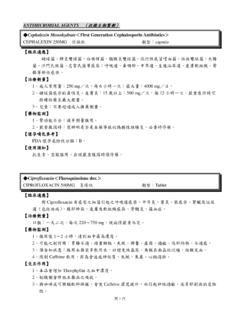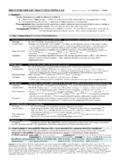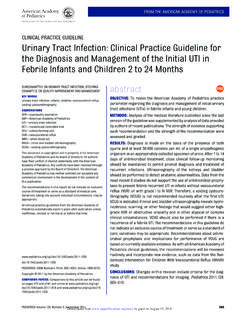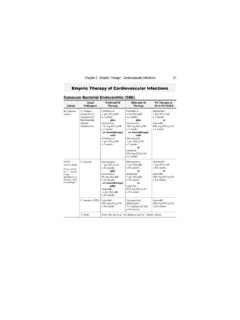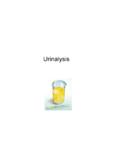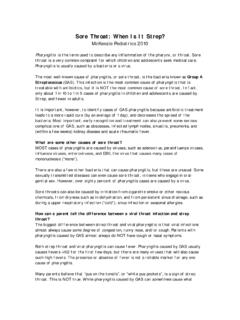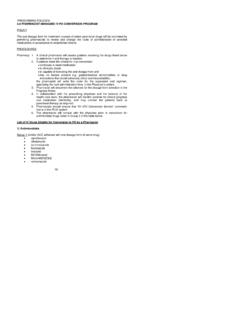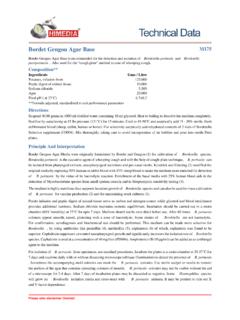Transcription of Staphylococcus, Malassezia, and Pseudomonas: …
1 Keith A. Hnilica DVM, MS, Dip. , malassezia , and pseudomonas : Why are they there and what to do about skin s normal structure and function serve as a very effective defense against infectiousagents. Normal skin is designed to keep normal flora in control and prevent of the SkinBarrier(1)Physical (Keeps the good stuff in and the bad out). of water, electrolyte & macromolecule of invasion by external agents: chemical,physical, microbial organisms(2)Physiologic (designed to kill or avoid organisms) rate - the routine turnover rate is 21 to 30 days for akeratinocyte to progress from basal layer to the surface. Injuriescause an increased mitotic rate resulting in a shorter time forkeratinocytes to reach the surface. The skin continuously sloughs tohelp get rid of nasty and fatty acids are bacteriostatic and salts are antimicrobial(3)Immunologic - The skin is the largest immunological surveylence 's cells (antigen presenting cells) in the , neutrophils, in sweat(4)Bacterial - the normal bacterial flora produces products that inhibit thegrowth of pathogensTemperature Regulation(1)hair coat(2)cutaneous vasculature(3)subcutaneous fat(4)sweat (species specific) - apocrine & cats - eccrine sweat in footpads onlySecretion(1)apocrine glands - pheromones(2)sebaceous glands - antimicrobial(3)epidermal lipids - wax sealKeith A.
2 Hnilica DVM, MS, Dip. the skin is affected by almost any primary disease (allergies, endocrinopathies,parasites, autoimmune skin disease, etc) the normal structure and function of the skin is changes cause the effective antimicrobial defenses (salts, acidity, turnover, temperature,dehydration, etc) to become dysfunctional. The result is increased colonization, invasion, andsecondary infections are secondary to the primary/underlying disease. Obviously, aggressiveantimicrobial therapies must be used to resolve the infection; however, until the primary skindisease is identified and controlled, the infections will continue to recur due to the changes in theskin that occur with skin disease the predispose to secondary skin with dermatitisEpidermis - Saran wrapTransformed into permeable paperDehydratedIncreased moisture allows organism adherenceand penetration Turnover every 21 daysTurnover rate is changed to prevent normalmaturation and exfoliation of cellsEssential fatty acids andwaxes: antimicrobialComposition is altered decreasing theantimicrobial functionalityLangerhans cells: searchfor antigens initiating adefense immune responseLangerhans cellswill preferentially stimulate anallergic response which is ineffective againstorganismsDermisVessels cool the skinVasodilatation increases skin temperature - warmGlandsSebum.
3 AntimicrobialIncreased and altered composition is lessantimicrobial and provided nutrients for yeastSweat: antimicrobialIncreased and altered composition increase skinmoistureAcidityIncreases in pH are less antimicrobialSaltsDiluted salt concentrations decrease theantimicrobial effectIgADecreases in IgA and switched to IgG secretiondecrease antimicrobial effectGeneralPruritus damages the skin and spreads organismsfrom the mouth to the A. Hnilica DVM, MS, Dip. PyodermaPyoderma (bacterial folliculitis) is the most common skin disease in dogs. Secondary pyoderma isa complicating factor in most dermatologic conditions. Approximately 80 percent of allergic dogswill have an active secondary pyoderma at the time of diagnosis. The secondary infectioncomplicates the evaluation and treatment of the patient due to its ability to alter the clinicalpattern of disease and response to bacteria are Gram-positive cocci that are commonly found on the skin of mostmammals.
4 Most of the staphylococcus organisms are innocuous inhabitants and cause fewproblems. There are several more aggressive (coagulase positive) species of Staphylococci thatare frequently associated with cutaneous disease. In dogs, staphylococcus intermediates is themost common cause of pyoderma; however, staphylococcus aureus and Staphylococcusschleiferi have been documented and are emerging as pathogenic key features make the coagulase positive Staphylococci particularly virulent pathogens. These bacteria are able to produce and secrete numerous cell products that cause severe - Degrades hyaluronic of connective tissue Coagulase - Converts fibrinogen to fibrin which causes clottingKinases - Converts plasminogen to plasmin which digests fibrin Leukocidin - Disrupts neutrophil membranes and causes discharge of lysosomesStaphylokinase - Activates plasmin-like proteolytic activity that dissolves clots Streptolysin - Repels phagocytes and disrupts phagocyte membrane and causesdischarge of lysosomal granules Hemolysins - Phospholipases or lecithinases that destroy cells by lysisProtein A - binds IgG in a non-functional orientation to avoid phagocytosisExfoliative toxin - Alter keratinocyte function causing blisteringExotoxins - Induce local tissue damage and inflamationToxin Shock Syndrome Toxins - Induce a severe systemic inflammatory reactionthat can be fatalSuper Antigen - Staph
5 Can cause a non-specific super immune response thatinduces systemic inflammatory changesStaphylococci are also particularly adept at avoiding the effects of antibiotics. In particular,methicillin-resistant Staphylococci have emerged as a serious medical problem. TheseStaphylococci are able to develop and transfer resistance to numerous antibiotics by means ofseveral divergent mechanisms. This flexibility allows them to rapidly adapt to new therapeuticstrategies. Unique strains of staphylococcus aureus have been identified that are resistant to allknown antibiotics. Until recently, these extremely resistant Staphylococci were limited to thespecies staphylococcus aureus and remained primarily a human dilemma. Recent reports haveidentified staphylococcus aureus infections in dogs that are multidrug resistant and potentiallyzoonotic. staphylococcus schleiferi has recently emerged as a common cause of caninepyoderma.
6 staphylococcus schleiferi has the ability to develop multidrug resistance (using similar mechanisms as staphylococcus aureus) and is known to be A. Hnilica DVM, MS, Dip. :The three essential components of successful treatment of secondary bacterial pyoderma in dogsinclude the proper selection of antibiotic, treatment with appropriate dose and duration ofantibiotic therapy, and the identification and control of all underlying dermatoses (allergies,endocrinopathies, autoimmune diseases, keratinization defects). Bacterial pyoderma is a commoncause of pruritus. For this reason, it is important to determine the cause of a patient s pruritus(pyoderma, yeast dermatitis, allergies) rather than treating the itch with steroids. Topical therapyis also of great benefit to help mechanically remove organisms as well as providing a nonantibioticmethod of killing the organisms. Shampoos containing chlorhexidine or benzoyl peroxide arehighly effective at reducing the superficial colonization of first time pyodermas:The overwhelming majority of first time bacterial pyodermas in dogs are caused byStaphylococcus intermedius.
7 This organism has demonstrated consistent sensitivity patternsmaking empiric antibiotic selection possible. Amoxicillin with clavulanic acid and cephalexin arecommonly used antibiotics that demonstrate good efficacy. Clindamycin, potentiated sulfur drugs,and erythromycin also demonstrate consistently good efficacy. The antibiotic selected should beused for a minimum of 21 days to eliminate the infection and allow the normal antimicrobialfunction of the skin to return to a more normal and effective function. If inappropriately lowdoses of antibiotic are used or if the duration of therapy is too short, the populations ofStaphylococci are altered so that antibacterial resistance strains are selected leading tochronic/recurrent chronic/recurrent pyodermas:Dogs with chronic/recurrent staphylococcus pyoderma almost always have an identifiableunderlying disease. This primary disease alters the normal structure and function of the skin andpredisposes the animal to secondary bacterial infections.
8 Until the underlying disease is identifiedand controlled, the secondary bacterial pyoderma will recur. The cycle of recurrent infection isfurther complicated by the frequent use of low-dose antibiotic therapy for inappropriately shortdurations. The result is a multidrug resistant staphylococcus species that requires moreaggressive diagnostic assessment through culture and antibiotic sensitivity profiles so theappropriate antibiotic can be with recurrent chronic staphylococcus pyoderma are more likely to develop multidrugresistant staphylococci species due to the long history of antibiotic treatment. It is usually best toperform a bacterial culture with antibiotic sensitivity profile to select an appropriate antibiotic fortreatment. In these patients it is even more crucial to use high dose antibiotic therapy with longdurations of resistant pyodermas:If the patient is on seemingly appropriate doses of antibiotic for an appropriate duration (minimumof 21 days) without clinical improvement in the papular crusting alopecia lesions, a resistantStaphylococcus infection should be suspected.
9 Other dermatoses that can mimic pyodermainclude Demodicosis, dermatophytosis, scabies, and pemphigus. Once these differentials havebeen eliminated, the skin lesions should be cultured and antibiotic sensitivity profile performed toKeith A. Hnilica DVM, MS, Dip. guide antimicrobial selection. It is especially important in these patients to use the highestpossible antibiotic dose for sufficient duration to completely resolve the infection. The antibioticsshould be continued for two to three weeks past complete clinical resolution to assure that theorganisms have been eliminated. If antibiotic therapy is discontinued prematurely, the resistantStaphylococcus populations will be allowed to expand making additional treatment even these cases high dose long-term treatment with fluoroquinolones seems to be an effectivetherapeutic option; however, resistance may develop especially with inappropriately low dose orshort duration.
10 Resistance to fluoroquinolones seems to be mediated by repeated exposure tosuboptimal doses of the antibiotics rather than a single mutation event. This suggests that as longas high doses are used for prolonged durations, fluoroquinolone resistance is unlikely to develop. It is essential that if the case fails to respond or seems to reach a state of stasis (never proceedingto complete resolution), the patient should be culture and antibiotic sensitivity panel be performedto appropriately modify the antibiotic treatment patients with multidrug resistant staphylococcus infections, it becomes paramount to find andcontrol the underlying dermatoses. Aggressive diagnostic workups should be used to explore theendocrine status and identify any allergic disease. Cutaneous biopsies are often useful todetermine if the patient has cutaneous changes typical of allergy, endocrine disease, autoimmuneskin disease, or a keratinization antibiotics and doses:Amoxicillin-clavulanate22 mg per kilogram every 12 hoursCephalexin22 mg per kilogram every eight hours30 mg per kilogram every 12 hoursClindamycin10 mg per kilogram every 12 hoursOrmetoprim mg per kilogram every 24 hours(on the first day give two doses q12 hours)Trimethoprim sulfa15-30 mg per kilogram every 12 hoursEnrofloxacin10-20 mg per kilogram every 24 hoursMarbofloxacin5 mg per kilogram every 24 mg per kilogram every 24 hoursKeith A.
